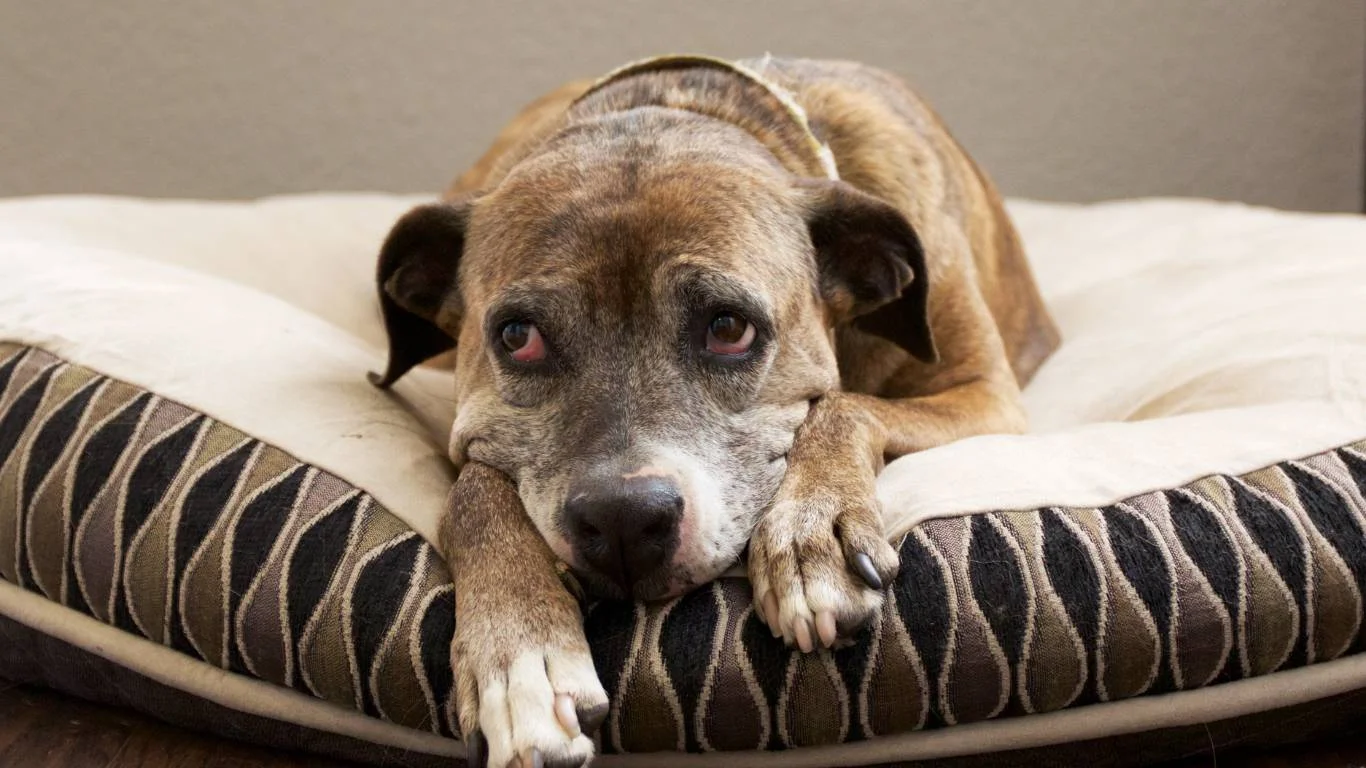7 Key Signs Your Dog Has a Problem with Their Liver You Need to Know
As a veterinary assistant with a focus on pet nutrition, I’ve seen firsthand how important it is for pet parents to be in tune with their dog’s health. One of the most concerning health issues you might encounter as a dog owner is liver problems. The liver is a vital organ responsible for detoxifying the body, producing important proteins, and even aiding in digestion. But just like humans, dogs can experience liver issues, and many times, these problems can be tricky to detect early on. That’s why knowing the signs your dog has a problem with their liver is crucial for getting them the right care in time.
What Happens When Your Dog’s Liver Is Struggling?
The liver plays a central role in your dog’s overall health. It’s responsible for filtering toxins, metabolizing nutrients, producing bile for digestion, and even storing important nutrients like vitamins. So when the liver starts to malfunction, it can affect almost every system in your dog’s body.
There are several conditions that can cause liver problems in dogs, including liver disease, infections, toxins, or even congenital liver issues. It’s important to note that liver disease often develops slowly, which means your dog may not show any symptoms until the problem is advanced. However, catching the signs early can make a huge difference in the outcome of treatment.
Now, you might be wondering how you can spot liver problems in your dog before they get worse. Well, in my experience as a veterinary assistant, I’ve seen several signs that can indicate something’s wrong with your dog’s liver. Let’s dive into the most common and noticeable symptoms that could be telling you your dog needs to see the vet.
Signs Your Dog Has a Problem with Their Liver
If your dog is having liver trouble, you might notice changes in their behavior or physical appearance. Sometimes these changes can be subtle, but other times, they can be pretty obvious. Let’s explore the key signs that could suggest your dog is dealing with liver issues.
1. Loss of Appetite
One of the first signs that something is wrong with your dog’s liver is a sudden loss of appetite. A healthy dog loves mealtime, but if your dog starts turning their nose up at their food or refuses to eat altogether, it could be a red flag. The liver plays a major role in digestion and appetite regulation, so when it’s struggling, your dog might not feel like eating. As a vet assistant, I’ve seen dogs with liver disease go from devouring meals to barely nibbling on their food, which is often a sign something isn’t right.
2. Vomiting or Diarrhea
If your dog is experiencing vomiting or diarrhea, especially if it’s persistent or accompanied by other symptoms like lethargy, it could be related to liver problems. Vomiting and diarrhea are common signs that the liver is not functioning properly and may be struggling to detoxify the body. In these cases, the liver is not doing its job of processing toxins, which can cause an upset stomach and gastrointestinal issues.
3. Jaundice: Yellowing of the Skin and Eyes
Jaundice is one of the most noticeable signs that your dog may have liver issues. It occurs when the liver is unable to process bilirubin (a substance produced during the breakdown of red blood cells), which then builds up in the bloodstream and causes the skin, gums, and eyes to turn yellow. This is a serious symptom that requires immediate veterinary attention. If you notice any yellowing of your dog’s skin or eyes, don’t wait—schedule a vet visit as soon as possible.

4. Increased Thirst and Urination
Have you noticed your dog drinking more water than usual or having to go outside to pee more frequently? Increased thirst and urination can be signs of liver problems. This happens because a malfunctioning liver affects the body’s ability to filter and process fluids properly. As a result, your dog may become dehydrated and drink more water to compensate. If you’re noticing an increase in your dog’s water intake or bathroom habits, it’s worth bringing up to your vet.
5. Abdominal Swelling or Pain
Another symptom of liver disease that I’ve seen in my work as a veterinary assistant is abdominal swelling. This happens when fluid accumulates in the abdomen due to liver dysfunction. If your dog’s belly looks bloated or feels firm to the touch, it could indicate liver failure or cirrhosis. This condition is often accompanied by pain, which may cause your dog to act more sluggish or avoid being touched around the belly area.

6. Unexplained Weight Loss
Unexplained weight loss is another common symptom of liver issues in dogs. When the liver is not functioning properly, it can impact your dog’s ability to absorb nutrients from their food. As a result, your dog may lose weight even if they are eating normally. This weight loss can happen gradually, so it’s important to monitor your dog’s weight and look for any signs that they’re not maintaining a healthy body condition.
7. Lethargy or Unusual Behavior
Liver problems can also affect your dog’s energy levels. If your dog seems unusually tired or lethargic, it might be because their liver is not working properly. The liver is responsible for processing nutrients, and if it’s not functioning at full capacity, your dog may feel sluggish or less motivated to play or exercise. If this behavior change is noticeable and persists, it could indicate that your dog is struggling with liver dysfunction.

What to Do If You Notice These Signs
If your dog is showing any of the signs mentioned above, it’s important to take them to the vet as soon as possible. Early detection and treatment are key to managing liver issues and preventing further complications. Your veterinarian will likely conduct a series of tests, including blood work and ultrasounds, to determine the exact cause of the problem. Based on the diagnosis, your vet will recommend the best course of action to get your dog back on track to better health.
Diagnosing Liver Problems in Dogs
If you’ve noticed any of the signs your dog has a problem with their liver, it’s time to get them to the vet for a proper diagnosis. I can’t stress enough how important it is to act quickly—liver problems, if caught early, can often be managed with treatment and a change in diet. But waiting too long can make it harder to treat, and in some cases, irreversible damage may occur. So, what exactly happens when you take your dog to the vet for liver issues? Let’s take a closer look at the diagnostic process.
Blood Tests: The First Step
When you bring your dog in, one of the first things the vet will likely do is run a series of blood tests. These tests can help identify liver function by measuring liver enzymes, bile acids, and other markers that indicate how well the liver is performing. As a veterinary assistant, I’ve seen these tests provide key insights into whether the liver is damaged or inflamed. If liver enzyme levels are elevated, it could indicate inflammation, infection, or even liver disease.
Another part of the blood test may involve checking your dog’s overall health and other organs. For example, a complete blood count (CBC) can give clues about whether there’s an underlying infection or anemia, which is common in dogs with liver problems. In my experience, getting these test results back early can make a world of difference in treatment options.
Ultrasound and X-Rays: Visualizing the Problem
After blood tests, your vet may recommend an ultrasound or X-rays to get a better look at your dog’s liver. An ultrasound is a great tool for seeing if the liver is enlarged, has abnormal growths, or has any visible damage. This step is crucial because it helps your vet assess the severity of the issue and whether it’s something like a tumor, cyst, or just generalized liver dysfunction.
X-rays may also be used to check for any abnormal fluid buildup in the abdomen, which can sometimes happen when the liver isn’t functioning well. From what I’ve seen at the clinic, ultrasound results can sometimes be the “aha” moment when we discover exactly what’s going on inside. It’s always a relief for both the pet owner and the vet to have a clear picture of what we’re dealing with!

Biopsy: A Definitive Diagnosis
In some cases, your vet might suggest a liver biopsy to get a definitive diagnosis. While this isn’t always necessary, it can help determine the exact cause of liver dysfunction. A liver biopsy involves taking a small tissue sample from the liver, which is then analyzed under a microscope. This is often the most accurate way to identify conditions like cirrhosis, liver cancer, or chronic hepatitis. I’ve seen this procedure used when the other tests don’t give a clear enough answer, and the results can really help guide the treatment plan moving forward.
Treating Liver Problems in Dogs
Once your vet has determined the cause of your dog’s liver issues, they’ll work with you to develop a treatment plan. As a veterinary assistant, I’ve witnessed a lot of success stories when dogs with liver problems get the right treatment early on. Let’s explore some of the common treatment options for liver issues in dogs and what you can expect.
Dietary Changes: Helping the Liver Heal
One of the most important aspects of managing liver problems is a special diet. I can’t tell you how many times I’ve seen dogs make major improvements just by switching to a liver-friendly food regimen. Dogs with liver issues often benefit from a low-protein, easily digestible diet. This type of diet takes the stress off the liver, allowing it to rest and heal.
In some cases, your vet may recommend a prescription diet specifically designed for dogs with liver problems. These foods are formulated with lower levels of protein, but they’re rich in the right nutrients to support liver health. In my experience, a high-quality, easily digestible food can help your dog feel better and even improve their overall energy levels.
Medications to Support the Liver
Along with dietary changes, your vet might prescribe medications to support your dog’s liver function. Medications such as denamarin (a combination of milk thistle and SAMe) are commonly used to help protect liver cells and improve liver function. These supplements help to reduce inflammation and encourage cell regeneration, which is essential when dealing with liver damage.
Other medications may be prescribed depending on the specific cause of the liver issue. For example, if your dog has an infection, antibiotics or antifungal medications might be required. If it’s a case of liver cirrhosis, your vet may recommend medications to control symptoms and prevent complications like fluid buildup or blood clotting problems. It’s important to follow the prescribed treatment plan closely and communicate with your vet if you notice any changes in your dog’s condition.
Managing Fluid Buildup: A Common Issue
As liver disease progresses, some dogs can develop ascites, which is the accumulation of fluid in the abdomen. This can cause swelling, discomfort, and difficulty breathing. In these cases, your vet may recommend diuretics (medications that help remove excess fluid from the body) or even perform a procedure to drain the fluid from the abdomen.
Draining the fluid isn’t a permanent solution, but it can help relieve pressure and make your dog feel more comfortable. I’ve seen many dogs who were really struggling with fluid buildup feel much better after a drainage procedure. However, this is often a temporary fix, and ongoing treatment and monitoring will be needed to prevent it from returning.

Regular Monitoring and Follow-Up Care
Treating liver disease in dogs often requires long-term monitoring and follow-up care. Your vet will likely want to see your dog for regular check-ups to monitor liver enzyme levels, check for any progression of the disease, and ensure that the treatment plan is working effectively. I always encourage pet owners to stay on top of these follow-up appointments because liver issues can sometimes be sneaky, and early detection of any new problems makes a big difference in treatment outcomes.
When to Consider More Advanced Treatments
In some cases, if your dog’s liver issues are severe or if they have liver failure, more advanced treatments may be necessary. These treatments might include surgery or even a liver transplant in extreme cases. While liver transplants are rare, they are sometimes considered for dogs with end-stage liver disease who don’t respond to other treatments.
While surgery or a transplant might sound intimidating, it’s important to remember that these options are available in certain situations and can give your dog a second chance at life. Your vet will discuss these options with you if they feel they’re appropriate for your dog’s specific condition.

Preventing Liver Problems in Dogs: Tips for a Healthier Liver
As a veterinary assistant, one of the most rewarding parts of my job is helping pet owners prevent health issues before they start. While some liver problems in dogs are unavoidable due to genetics or unavoidable illness, there are definitely things you can do as a pet parent to help protect your dog’s liver and keep it as healthy as possible. Prevention is always better than treatment, and with a little care and attention, you can greatly reduce your dog’s chances of developing liver issues.
1. Maintain a Healthy Diet
Diet plays a massive role in your dog’s overall health, including their liver. When I work with pet owners at the clinic, one of the first things we look at is their dog’s diet. Dogs that are fed a balanced, high-quality food tend to have fewer health problems overall, and that includes liver issues.
Feeding your dog food that’s rich in high-quality proteins, healthy fats, and appropriate vitamins and minerals is essential. For dogs with liver problems, your vet may recommend a special diet, but for overall health, aim for a food that supports liver function without overloading it. If you’re unsure whether your dog’s food is up to par, your vet can help guide you in selecting the best option based on your dog’s breed, size, and age.
Also, be mindful of feeding your dog human food, especially toxic items like onions, garlic, or chocolate, which can damage the liver. I can’t tell you how many times I’ve seen dogs who have developed liver issues due to accidental ingestion of harmful foods. Keeping these out of your dog’s reach is key to prevention.
2. Regular Vet Checkups
Regular vet visits are essential in catching liver problems (or any health issues) before they become more serious. During routine checkups, your vet will likely perform a full physical exam and might even recommend blood work or other tests to monitor liver function, especially if your dog is aging or has a preexisting condition.
As a vet assistant, I see pets all the time who come in for a routine check-up and it’s during that appointment that we notice signs of potential liver problems. Early detection makes all the difference. If you notice any changes in your dog’s appetite, energy level, or behavior, don’t wait for the next scheduled visit—bring them in for an evaluation. Catching problems early gives your dog a better chance at successful treatment and recovery.
3. Limit Exposure to Toxins
Many liver issues in dogs are caused by toxins, whether that’s chemicals, medications, or even plants that are toxic to pets. It’s super important to keep harmful substances out of your dog’s environment. For example, certain household cleaners, pesticides, and some human medications can be extremely toxic to dogs if ingested or absorbed through their skin.
In my experience, many liver problems I’ve seen at the clinic stem from exposure to toxins, either through ingesting something they shouldn’t have or through environmental factors. Be careful with plants around your home, too—common plants like lilies, sago palms, and azaleas can cause serious liver damage if your dog chews on them. Always check for potential hazards in your home and yard, and keep your dog safe by removing any dangerous items they might be curious about.

4. Manage Your Dog’s Weight
Obesity is a serious issue for dogs, and it can affect the liver in a big way. When dogs are overweight, it puts extra strain on their liver, which can lead to fatty liver disease or other liver-related problems. As a vet assistant, I’ve worked with a lot of pet owners whose dogs developed liver issues because they didn’t manage their weight properly.
Maintaining a healthy weight for your dog is crucial to their liver health. Make sure you’re feeding them an appropriate portion size for their size, breed, and activity level. Regular exercise, even just daily walks or playtime in the yard, can also help keep your dog’s weight in check. If you’re concerned about your dog’s weight or body condition, your vet can help guide you on how to get them to a healthier weight.
What to Expect in the Long-Term: Managing Chronic Liver Issues
Unfortunately, in some cases, liver problems in dogs are chronic and require long-term management. While it’s always best to catch liver issues early, even if your dog’s liver condition is more advanced, they can often still live a happy life with the right care. Chronic liver disease requires ongoing monitoring, medication, and sometimes special diets, but with your vet’s help, you can work to keep your dog comfortable and healthy.
1. Lifelong Medications and Dietary Adjustments
For dogs with chronic liver conditions, ongoing medication is often necessary. These medications can help manage symptoms, prevent further liver damage, and support liver function. In some cases, dogs may need to take medications for the rest of their lives, but many dogs do very well on them.
Diet will also play a big role in managing chronic liver disease. Your vet may recommend a specialized prescription diet that’s low in copper and easy to digest, which can help reduce strain on the liver. These diets often include ingredients that support liver function and prevent further damage.
As a veterinary assistant, I’ve seen dogs with chronic liver disease thrive when they stick to their treatment plan, including regular vet visits, medications, and a carefully managed diet. While it may feel overwhelming at first, with the right routine, many dogs can live long, comfortable lives.
2. Regular Follow-ups and Monitoring
Chronic liver disease isn’t something you can just treat and forget about. It requires ongoing attention and monitoring to make sure your dog stays on track. Your vet will likely want to check in regularly, sometimes as often as every 6 months, to monitor liver function through blood tests and physical exams.
In between vet visits, keep an eye on your dog’s behavior and health. Any changes in appetite, energy level, or symptoms like vomiting or diarrhea should be reported to your vet immediately. Early intervention can help prevent serious complications and improve your dog’s quality of life.
References
For more information on liver health in dogs, you can visit trusted resources like PetMD, American Kennel Club, and National Institutes of Health. These sites provide a wealth of information on preventing, diagnosing, and managing liver disease in dogs.
Disclaimer
The information provided in this article is intended for informational purposes only and should not replace professional veterinary advice. Always consult with your veterinarian for an accurate diagnosis and treatment plan for your dog’s health concerns. Each dog is unique, and their treatment needs will vary based on their specific condition and overall health.





